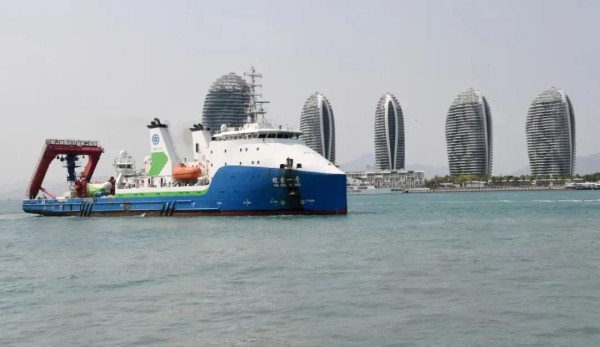Fendouzhe, means "Striver", China's deepsea manned submersible carried by the scientific research ship Tansuo 1, completed its first international manned deep-diving scientific research mission in waters surrounding Oceania on March 11.
Fendouzhe is a core development focus of national key deepsea technology and equipment for the nation's 13th Five-Year Plan (2016-20) period.
China State Shipbuilding Corporation Limited (CSSC) was responsible for the general design and integrated construction of the submersible.
Its development and successful trial operation greatly improved the independent innovation level of China's deepsea equipment technology.

A view of the scientific research ship Tansuo-1, carrying Fendouzhe, the deepsea manned submersible, as it navigates on the sea [Photo/sasac.gov.cn]
The Tansuo 1 scientific research ship was renovated from the HAI YANG SHI YOU 299 multifunctional workboat in 2016 by CSSC's Guangzhou Shipyard International Company Limited. It began carrying Fendouzhe in 2020.
With a total length of 94.45 meters and a width of 17.9 meters, the ship has a displacement of 6,250 metric tons and is capable of navigating for more than 10,000 nautical miles. In order to meet upgrading requirements for 10,000-meter manned submersible research, the ship has been renovated three times.
Initiated by the Institute of Deep-sea Science and Engineering of the Chinese Academy of Sciences, the expedition started in October 2022 from Sanya, South China's Hainan Province, and traveled for 157 days, sailing more than 22,000 nautical miles around Oceania.
Ten domestic and international organizations participated in the voyage, during which the Fendouzhe carried out 63 dives, four of which exceeded a depth of 10,000 meters.
During the voyage, the scientific research team carried out the first international large-scale and systematic manned deep-diving investigation in the Kermadec Trench region in the Southwest Pacific, and reached the bottom of the Diamantina Abyss and the Valleby-Gennes Abyss in the southeast Indian Ocean for the first time, collecting samples of abyssal macro-organisms, rocks, concretions, sediments and water.
The samples are expected to support research on the evolution and adaptation mechanism of abyssal life and the evolution of the related l sedimentary environment.
(Executive editor: Xie Yunxiao)